Marketing sprints are a staple of agile marketing but the hyper-productive philosophy they encompass can benefit any marketing team – especially if you ever feel your workload getting on top of you. If you’re new to agile marketing, you can take a look at our in-depth guide and our step-by-step walkthrough on how to implement agile marketing.
If you’re already familiar with agile marketing but looking for help with planning your sprint runs, this is the article for you. Today, we explain the role of marketing sprints, how to plan them effectively and run you through the process of running your first sprint.
What are we looking at in this article?
In this guide, we cover everything you need to know about marketing sprints and take you through the process of running them. We’ve broken this article up into several sections and here’s a quick preview of what’s coming up:
- What is a marketing sprint?: A definition of the marketing sprint and its key benefits.
- Sprints in agile marketing: The role of sprint runs in agile marketing and why they’re the driving force of progress.
- Sprint anatomy: Everything you need to plan your first sprint.
- How to plan your first sprint: A step-by-step guide to planning marketing sprints.
- Running your first marketing sprint: An example guide to running your first marketing sprint.
After quickly running through the basic essentials of sprint marketing, we break down the key components of an effective sprint. Then, we have two step-by-step walkthroughs: one explaining how to plan marketing sprints and the second, showing you how to run your first sprint.
What is a marketing sprint?
The marketing sprint originates from a planning methodology developed by Google Ventures’ Jake Knapp in 2009. The concept is designed to help teams achieve more in shorter spaces of time by focusing on one big goal and putting all available resources into achieving it over a five-day period.
Knowing where the sprint emerged from, it comes as no surprise that it was devised with tech startups and ventures in mind.
For example, a team of developers may run a sprint with the goal of building a working prototype of a new product in five days. Later, the same team may run further sprints to develop, test and launch the product in question, focusing all of their attention on achieving each goal, one by one.
“Sprint planning overhauls your project management process and allows you to go from zero to prototype in just five days — or, in the case of a marketing campaign, from zero to campaign concept.”
Nathaniel Medina and Chris Eberhardt, How Our Marketing Team Used Sprint Planning While Working Remotely – HubSpot
Sprint runs were soon adopted by agile teams, thanks to their focus on short time frames and goal achievement making them ideal for the rapidly changing needs of dynamic ventures. Over time, the sprint concept was adapted for marketing teams and the five-day template gradually expanded.
Now, it’s generally accepted that a marketing sprint can run from anywhere between 5-14 days and, possibly, a little longer – although you start to lose the agility they encompass as you approach the ~30-day region.
In 2016, former Google Ventures and YouTube designer, John Zeratsky, published an article on Harvard Business Review, entitled Sprints Are the Secret to Getting More Done. In his article, Zeratsky lists some of the key benefits of the sprint methodology and, as a former Google Ventures figure himself and best-selling author of (among other things) Sprint: How to Solve Big Problems and Test New Ideas in Just Five Days, the man knows what he’s talking about.
Here’s a summary of the benefits he lists in his HBR article:
- Sprints help you start: Sprints make an excellent commitment device — when you gather a team, clear the calendar and schedule customer interviews, you commit to making progress.
- Sprints move you from abstract to concrete: Sprints force you to make fast progress and prevent your projects getting stuck in “an alternate universe where debates, theories, and hunches are plentiful”.
- Sprints keep you focused on what’s important: Every sprint starts with an entire day devoted to mapping out the problem at hand so the whole team knows exactly what the challenge is and all of their time is focused on overcoming it.
- Sprints force crisp decision-making: Sprints force teams out of the “business-as-usual” mentality that creates a habit of striving for consensus, avoiding tough calls and a lack of transparency about how decisions are made.
- Sprints encourage fast follow-up: Your team will accomplish a ton in every sprint, but the knock-on effects — the confidence of knowing you’re on the right road — are even more powerful.
I would add another important benefit to that list to acknowledge the fact that marketing sprints place emphasis on rapid results – ie: achieving the goal in the fastest of most efficient manner possible. It forces you to prioritise progress over perfection, agility over rigid processes and consistent goal achievement over everything else.
Marketing sprints define ambitious goals that are achievable in a short time frame and encourage you to put all of your resources into achieving them – without any distractions.
The role of marketing sprints in agile marketing
We’ve addressed the role of sprint runs in agile marketing before, in our ultimate guide to agile marketing. We describe sprints as “power sessions that typically last anywhere between one and six weeks on a project, experiment or task with a defined goal”.
And we reiterate the importance that “each sprint has a clearly defined goal that’s both achievable and measurable”.
The key characteristic here is that every sprint is designed to achieve something meaningful and do so in a short time frame. The agile methodology is all about rapid progress and fast response to changes so that you’re constantly moving in the right direction and capable of adapting to changes (both positive and negative) quickly.
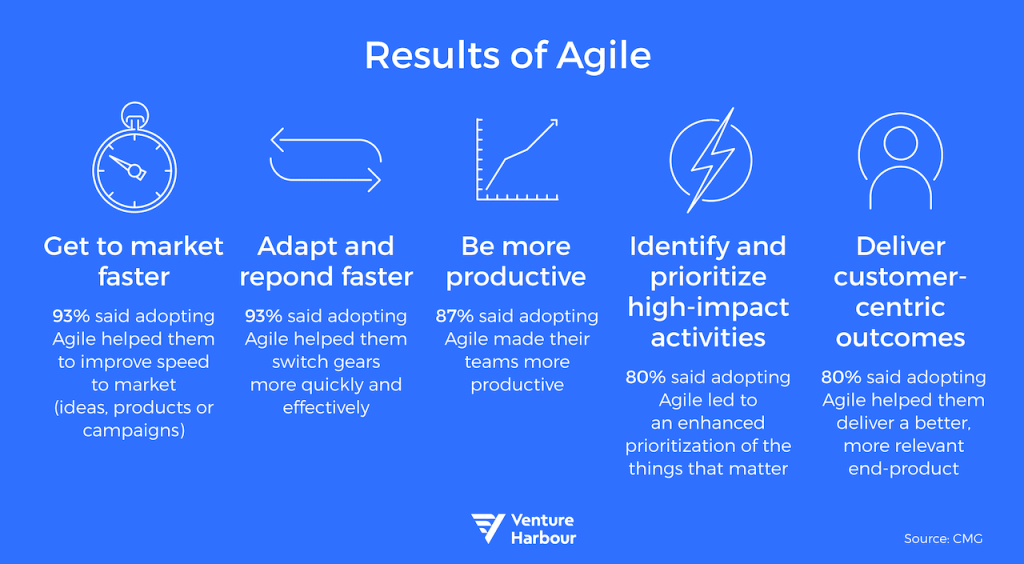
With the agile framework, software companies can roll out new features, identify bugs, update their products, respond to competitor actions and other crucial tasks in weeks, not months.
Sprint runs are the key protagonist in agile marketing – a series of hyper-focused sessions where team members put all of their efforts into achieving big goals. Every day, your team is tasked with fulfilling an objective that takes you a significant step closer to achieving the goal of your sprint run.
The rapid, progress-oriented nature of sprints means your team is driven to hit targets on a daily basis, which keeps motivation and expectations high throughout the run.
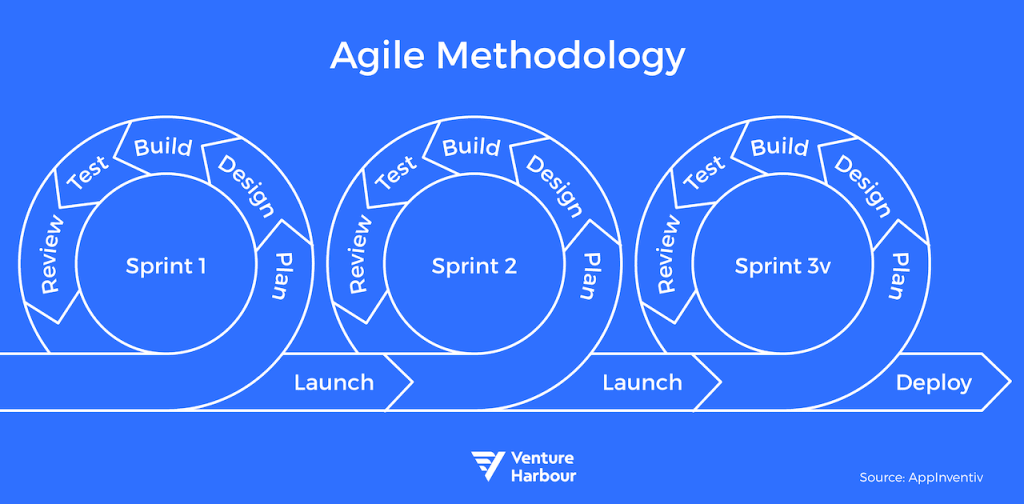
As you can see in the graphic above, there are five key stages of the traditional sprint and (if you’re following the classic Jake Knapp framework) each of these should be completed in a day, hence the five-day sprint run.
The five stages are:
- Plan: Setting goals, identifying potential challenges and putting everything in place to succeed (tools, resources, campaign ideas, etc.).
- Design: Create a working prototype of the product, feature or campaign (including any assets required, such as landing page mockups).
- Build: Develop the product, feature or campaign ready for deployment.
- Test: Test and optimise the product, feature or campaign to ensure goal completion.
- Review: Run a sprint review to access the successes, failures and opportunities to improve.
Like agile marketing itself, the original sprint format was designed for software development and you can see this in the design, build and test stages of the process above. However, marketers have adopted and adapted this framework over the years, inspired by the modern age of tech startups that blur the lines between product development and marketing.
So you may not be designing prototypes of a new product feature or building a software update in stage #2. Instead, you could be designing a marketing campaign with a new conversion path, landing page, content and automated email marketing workflow.
You’re also not limited to running five-day sprints. In fact, we find out most effective sprints run for anywhere between 7-14 while some even last up to 21 days. This allows more time for the design and build stages but, more importantly, it gives us more time to test and optimise campaigns to ensure we’re hitting targets by the end of every sprint.
This is typical of marketing sprints because campaigns typically need to run for a while before you have enough data to accurately measure results and, then, you often have to dedicate multiple days to testing different solutions and measuring results.
That said, you still want to keep sprints as short as possible and technology can help us overcome some of the challenges of analysis in marketing sprints.
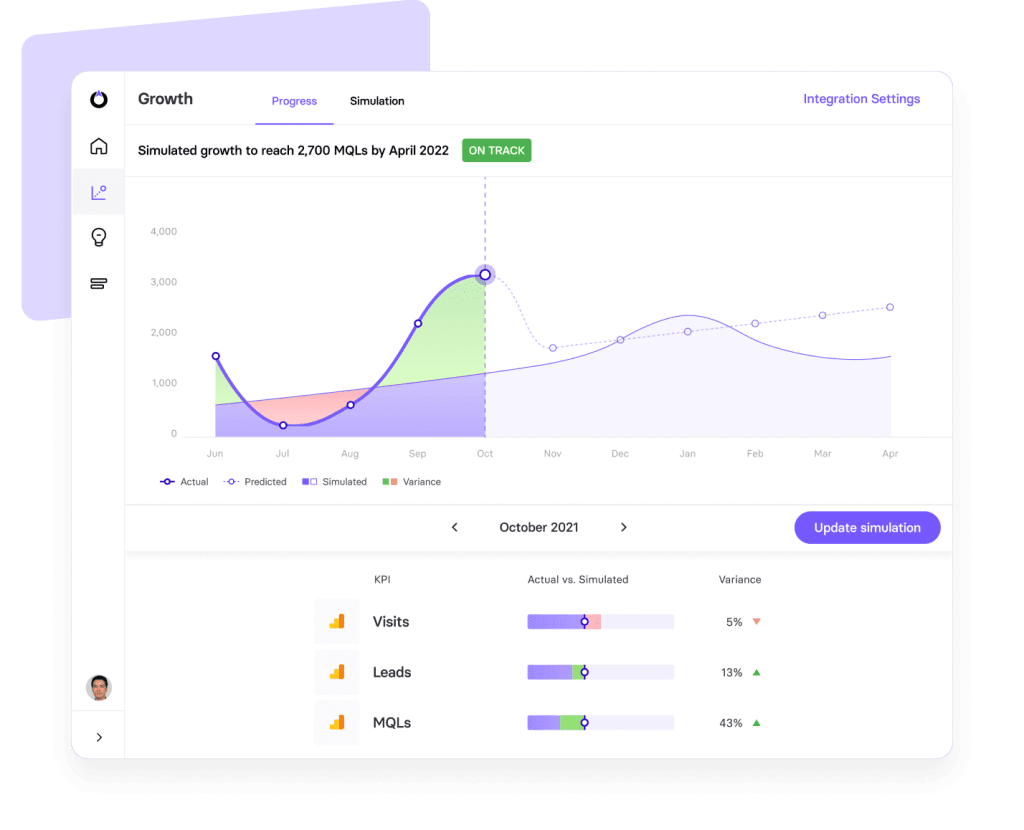
TrueNorth is our marketing management system and the platform includes an innovative campaign simulator that allows us to predict the performance of campaign ideas before we allocate any resources to them. This helps us choose and prioritise campaign ideas for our sprint runs and it also gives us reliable targets to aim for at every stage of the campaign.
As a result, we have a good idea of what to expect from performance data after campaign launch and we don’t have to sit idle while collecting preliminary data. We can tick campaigns off as a success sooner and take action earlier, as soon as performance deviates from predictions, which allows us to run short sprints without any compromise on our analytics and testing process.
The anatomy of effective sprint planning
To effectively plan a marketing sprint, you first need to understand the anatomy and key components. In this section, we explore each of these components so you can plan for them effectively with every sprint.
First, here’s a summary of the anatomy we’re discussing:
- The sprint planning meeting: The collaborative meeting where the plan for your next sprint is put together.
- Sprint goals: Clear goals and objectives for every marketing sprint.
- Marketing backlog: The list of marketing tasks a team needs to complete to achieve the sprint goal.
- Story points: The estimated time required and difficulty of completing tasks.
- The Scrum team: A flexible, high-performance team capable of completing successive sprints.
- Roles & tasks: Clearly assigned roles within the team and appropriate tasks assigned to individuals.
- The right tools: The required tools, available for everyone who needs them.
- Attribution & accountability: A system for attributing success and failure to campaigns, tasks, teams and individuals.
- Analysis & review: A retrospective system for analysis and review of the sprint.
Every sprint plan you create should include the above and you may need to add other components based don’t the type of sprint you’re running. For example, you may need to collaborate with other teams during certain sprints, such as the customer support department for a campaign designed to increase customer retention, and plan for liaison between both teams.
However, we’re going to keep things simple by focusing on the fundamentals in this section.
The sprint planning meeting
The sprint planning meeting is the group session where your team gets together to lay out the plan for the next sprint run. This should happen a few days before the sprint is scheduled to begin and this should be the longest meeting of the entire process because you need to make sure everything is in place before the sprint kicks off.
Our sprint planning meetings often last several hours and most of the collaborative planning work is completed during this meeting.
This doesn’t mean we go into the meeting without any prior planning, though. By the time we sit down, we already have a broad idea of what we’re aiming to achieve and a provisional list of ideas that we can discuss. By the time we’re done with the sprint planning meeting, we should have a clear roadmap of how the sprint will run, the specific goals we’re trying to achieve and what everyone needs to do.
To do this effectively, we have to identify potential challenges we’re going to face during the sprint and prepare for them in any way we can – eg: investing in specific tools, putting certain resources in place or outsourcing certain tasks.
We also have to calculate the time and difficulty of each marketing task so we can ensure the sprint stays on schedule and achieves our goal(s). This practice results in a data point called “story points” that predicts the time each task requires while considering the expected difficulty and other resources required to complete the task in question.
The only way to get accurate story points is to use historical data and evaluate sprints upon their completion so you can apply these findings to future plans.
More on this shortly.
Sprint goals & objectives
Every sprint should have a clear goal or set of goals, including objectives or milestones you need to hit in order to complete these goals within the sprint time frame. We’ve discussed the difference between marketing goals and marketing objectives many times on our blog but it’s a common point of confusion so it’s worth quickly summarising the difference.
- A marketing goal is a broad, long-term result you want to achieve, such as increasing revenue, reducing customer churn, increasing engagement by 40%, etc.
- A marketing objective defines the specific, measurable actions marketers must complete to achieve specific goals. For example, if your goal is to reduce customer churn, one objective might be to increase email open rates by 30+%.
Given the short time, high output nature of marketing sprints, every task your team conducts should contribute to a specific objective and/or the primary sprint goal. This should be clear from your sprint planning meeting and finalised before the sprint begins so everyone knows what they’re doing at any given time and why.
To ensure these actions truly are contributing to your goals when the sprint is running, you have to know exactly which KPIs and metrics measure success. Team members also benefit from seeing the impact of their actions so it’s worth having a marketing management system that includes accessible reporting of these same metrics and attributes performance to the actions of individuals.
Marketing task backlog
A backlog is a complete list of the tasks that need completing in order to achieve the task goal and you should prioritise these tasks in order of importance during your sprint planning meeting.
Actually, we’ve got a little trick up our sleeves for prioritising tasks before we head into our meetings and it brings us back to another feature in TrueNorth. We create our backlog in TrueNorth and use the simulator to predict outcomes, which allows us to automatically prioritise tasks based on projected results, expected impact, our confidence in completing the task successfully and the difficulty of doing so.
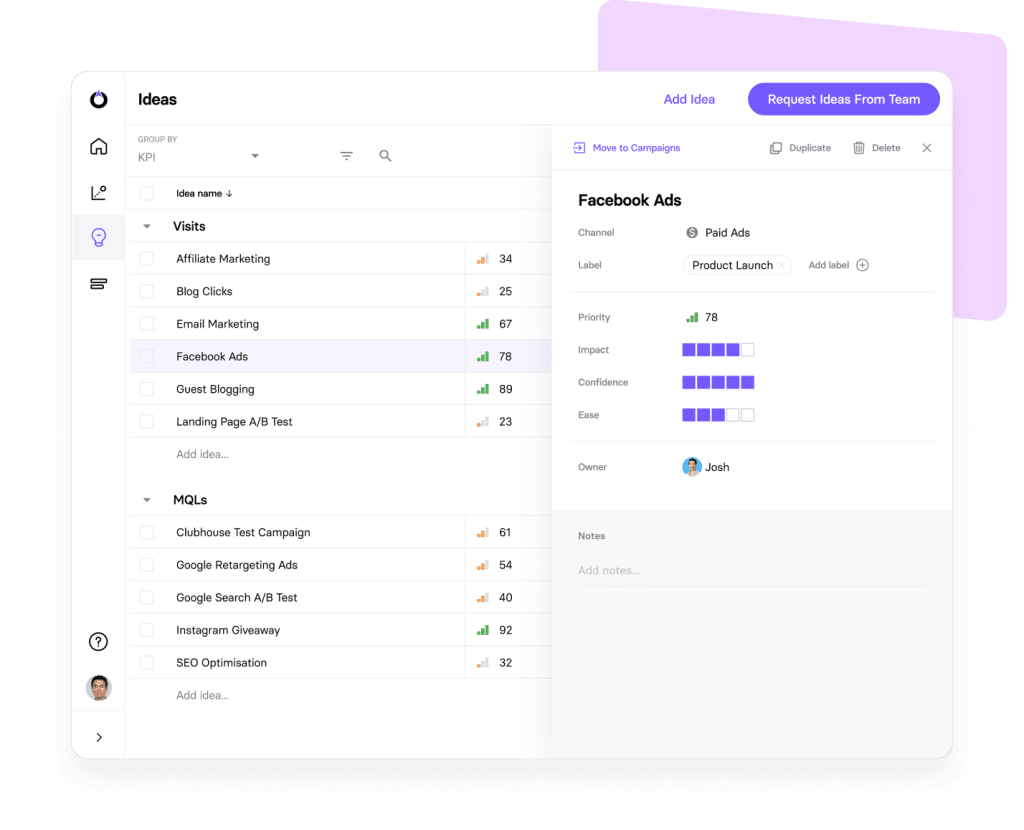
This means we head into our meetings with a prioritised list of tasks ready to discuss and expand upon. We can address the low-priority tasks as a team and explore ideas that may increase their value and confirm the high-ranking tasks deserve to sit at the top of our backlog.
This one feature means we’ve already built up momentum before we sit down in our sprint planning meeting and we’re ready to start putting ideas together as soon as the conversation begins.
Story points
As we explained earlier, story points predict the time it takes to complete tasks in your backlog while considering the resources required (time, personnel, tools, etc.) and the expected difficulty of each task. This helps you determine which items in the backlog your team can realistically complete during the sprint and find a combination that will achieve your goal.
This is crucial for effective sprint running because you’ve got a short, fixed time frame to hit your targets and you can’t afford to have time-consuming tasks halt progress.
An ability to accurately estimate stories is one of the biggest assets you can have in sprint planning but this isn’t so much about skill or intuition. It’s about data. You need to constantly analyse marketing performance and productivity to accurately predict how long future tasks will take to complete.
There are plenty of project management platforms that include time tracking features so you can see exactly how long tasks take to complete. Many platforms, such as Status Hero, allow you to track task completion times of individual team members but there are some obvious privacy questions that need asking before you monitor the daily activity of individuals.
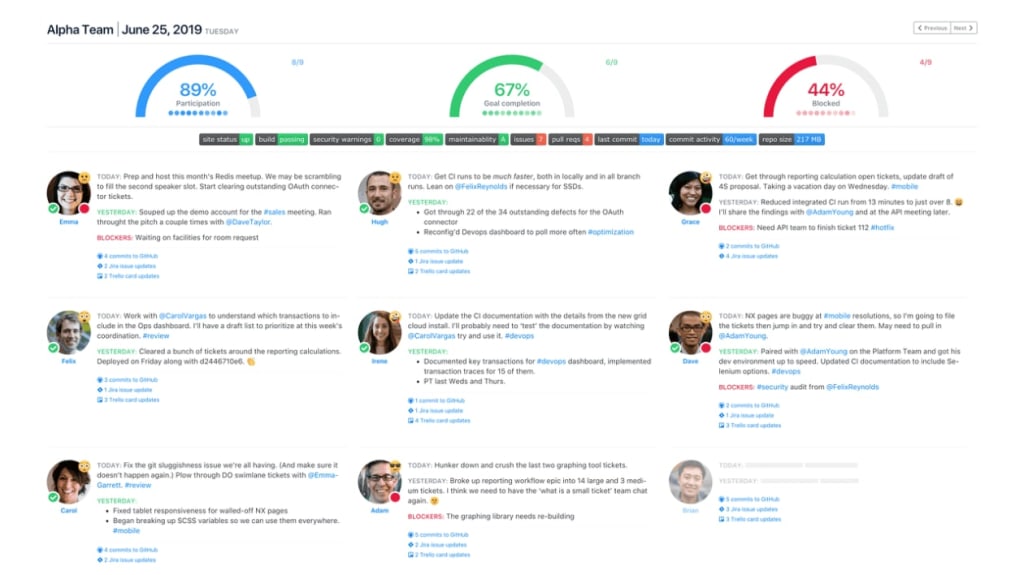
If you or your team has issues with time tracking, you can implement a system that anonymises data and averages out completion times. Alternatively, you could develop a system that only identifies the top performer for certain tasks that have been performed by multiple individuals and keep everyone else anonymous.
The point is, there are technology options for every level of data quality and privacy protection but there’s a certain compromise between the two.
Whatever method you use for estimating story points, the more accurate your calculations are, the more your sprints will run on schedule. Accurate measurements allow you to piece together a sprint with the right combination of backlog tasks that will complete your goal in the given time frame.
In some cases, you may find that you can’t put a combination together that makes your goal achievable within the time frame you’ve set. In which cases, you can extend the duration of your sprint run and make the necessary adjustments to your schedule. This may mean pushing the next sprint back a few days or asking certain team members to put in some extra hours over the next week.
Either way, you know what time constraints you’re working with and you can make any necessary adjustments before the sprint begins.
The Scrum team
Sprint runs are part of the Scrum framework, the original agile methodology developed by software teams in the 1980s. So the Scrum team is the small group of individuals who participate in each sprint run and these are generally small teams of 5-11 people with the required skills for each task selected from the backlog.
We’ve discussed the structure and management of marketing teams in detail before but your Scrum team is a carefully selected collective capable of achieving your sprint goal, hand-picked from the full team you have available.
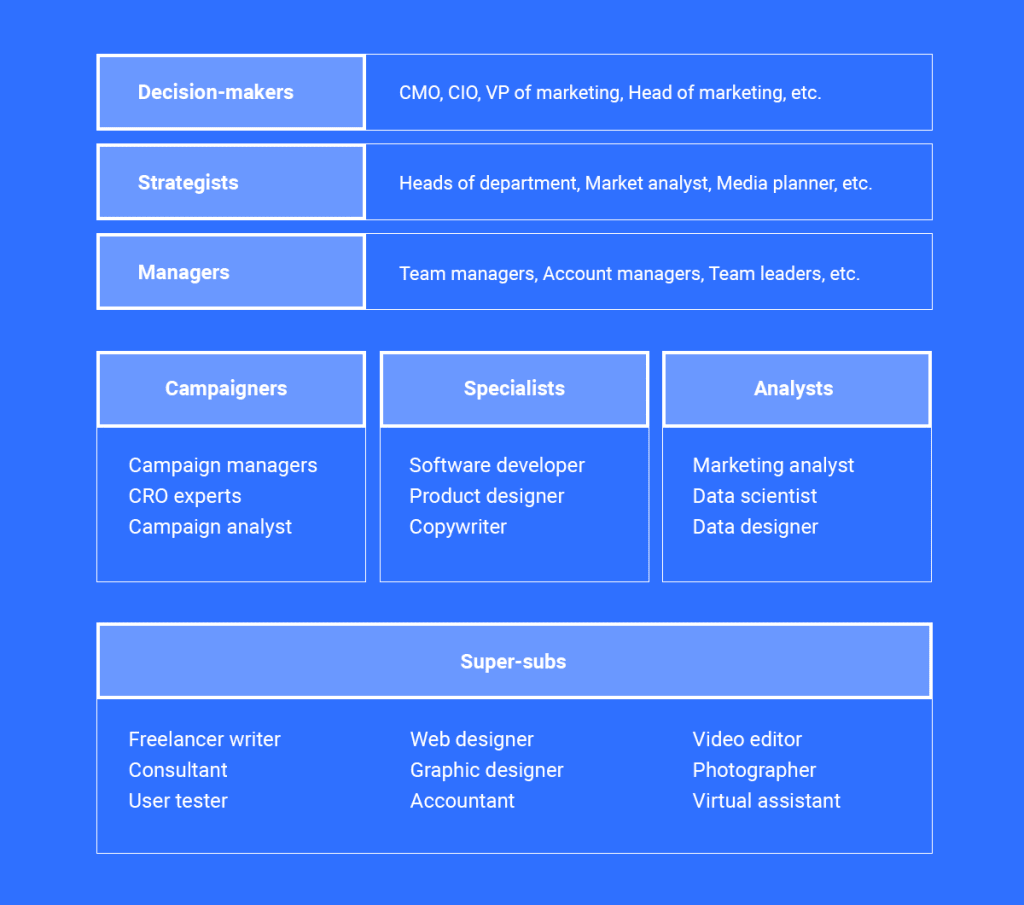
So you don’t want your entire team working on any single sprint run. Instead, you pick the most suitable team of individuals for each sprint, based on the goals you’re aiming to achieve and the skill sets required for the tasks that need completing along the way.
Let’s say you’re running a sprint to launch a marketing campaign for the release of a new product. Your Scrum team might consist of the following individuals:
- Designer for landing pages, emails and other promotional resources.
- Developer for building landing pages, optimising pages (eg: pricing page), etc.
- Content strategist to orchestrate your promotional campaigns.
- Copywriter for landing pages, ads, email, etc.
- Content writer for blog posts and outreach articles.
- PPC advertiser for running Google Ads and social ad campaigns.
- Data analyst for tracking performance and optimising results.
You can include more people in your sprint planning meetings, especially ideas people who can help you devise the best approach, but your actual Scrum team that comes together for the sprint itself should be a lean pool of talent with the skillset that’s going to achieve the sprint goal.
You may find your Scrum team gets smaller as the sprint runs, too. For example, teams often include several strategic minds for the first day of research and planning but these individuals aren’t always needed for the latter stages of the sprint. So our imaginary content strategist in the list above may only join the Scrum team for the first day before bowing out to let everyone else crack on with producing the goods.
The right tools for every job
We don’t need to spend too much time talking about this one but the key point is that you need to have every required tool in place before the sprint starts. You want to be familiar with these tools, too, because you don’t have time for learning curves or unexpected issues with setting things up.
By this point, you should have picked your tasks from the backlog, put your team together and have a good idea of how your sprint run will pan out. Now, you have to assess the workload of the team and each individual and make sure all of the required tools are available to everyone who needs them and ready to use.
To ensure you cover everything, work through the stories and tasks set out in your sprint plan and determine which tools are required. Hopefully, you’ve already got all or most of the tools you need but you may need to bring in some new tools or upgrade some existing ones to improve your team’s workflow – just make sure they’re set up and ready to use before the sprint starts.
Also, speak to your team as a group during the planning meeting to discuss any other tools that are needed or could benefit the sprint. Give individual team members a chance to speak up, too, and allow them to raise any concerns with the existing tools you have on board, especially if there are concerns that issues could jeopardise the sprint goals.
Attribution & accountability
A key characteristic of sprint runs (and agile marketing, in general) is learning from the successes and failures of everything you do. The more you learn from previous experience, the better equipped you are to achieve future sprint goals within short time frames and improve the performance of your team with every sprint you run.
This level of learning starts with accurate attribution and accountability. You have to know why each objective and goal is achieved or missed. You need to know which marketing actions are responsible for achieving goals and the specific actions that result in failure.
Like many things we’ve talked about in this article, the answers lie in your data but you need a system in place that’s capable of attributing outcomes to specific actions. This brings us back to having the right tools for the job but a marketing sprint can involve a wide range of activities and you’re not going to get full coverage from one software solution.
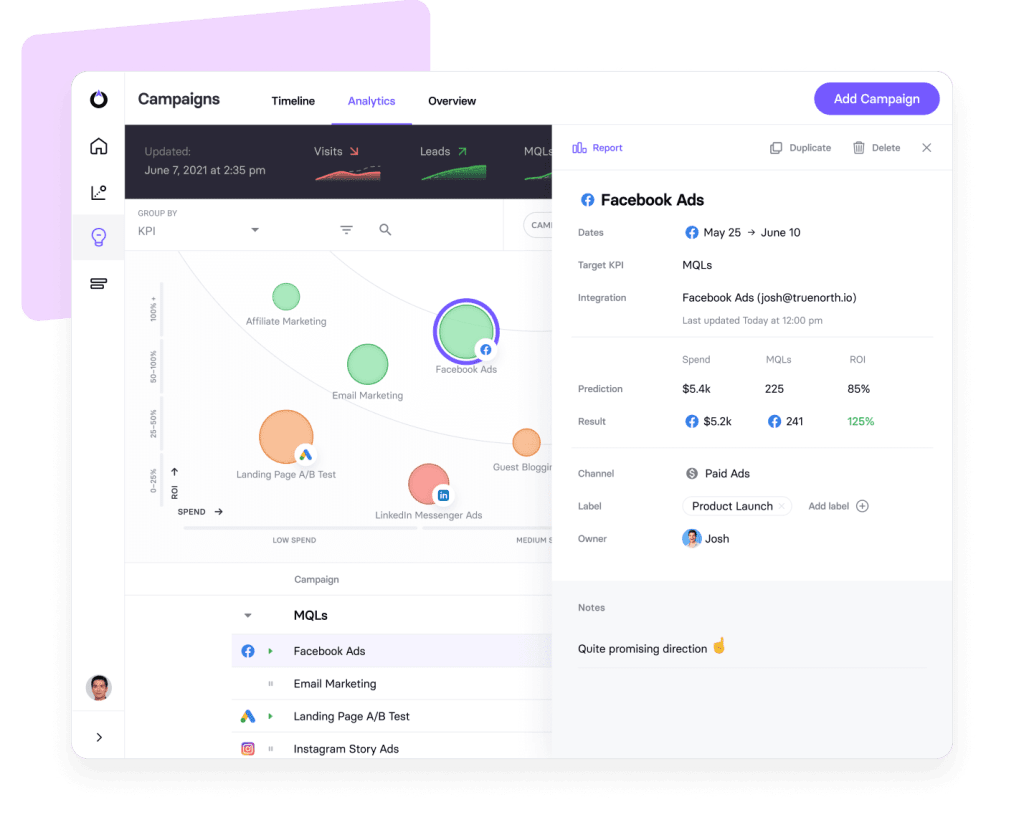
For example, there are plenty of analytics platforms available that attribute conversions and other user actions to campaign events, such as ads, landing page visits, social interactions, etc. But these platforms aren’t going to attribute the actions of your team or the effectiveness of your marketing processes to goal achievements or failures – all of which is important information for running successful marketing sprints.
What happens if you launch a campaign that falls flat, except the issue isn’t with the campaign itself, but the fact it was launched too late to gain traction before the sprint ended?
Simply attributing conversions to campaigns, clicks, impressions, etc. isn’t enough to assess the performance of your marketing actions in a sprint run. You also need to monitor the performance of your marketing processes to maximise effectiveness.
If you’re launching a campaign too late to get the results you need in time, the question is: how could you launch the same campaign faster next time? By analysing your ideation, approval and campaign launching process, you may find opportunities to speed up the planning and implementation of new campaigns – a powerful improvement for running effective sprint runs.
Analysis & review
At the end of every sprint run, you should hold a review meeting, often called a marketing retrospective or a sprint review, where you analyse the results and processes of the sprint. The aim is to determine what went well, what didn’t and what can be improved in future sprints.
At the end of each sprint review, you should have a record of the following:
- What to keep doing for similar campaigns, strategies and marketing actions.
- What to stop doing or optimise to improve results in similar scenarios.
- What to do differently in your marketing processes for future campaigns.
As we’ve mentioned several times in this article, learning from previous sprints is an integral part of the Scrum agile framework. The spent review is where you should discuss these lessons and the majority of this meeting should be spent analysing data and getting feedback from team members.
If you’ve got the right attribution system set up, there shouldn’t be any room for speculation on what worked and what didn’t but you may need to explore certain points to understand why certain things happened. For example, you might need to speak to the developer to find out why a bug fix took longer than scheduled.
By the end of your sprint review, you should leave with a list of next steps to complete that will improve the results of future sprints of your marketing processes, in general. It’s worth prioritising these tasks in order of importance or grouping them into categories, such as:
- Immediate tasks: Tasks individuals and teams need to complete as soon as the meeting is over.
- Short-term tasks: The items that should be completed on the day of the meeting or a fixed short-term deadline.
- Mid-term tasks: These should be completed by the end of the week or a specified deadline.
- Long-term tasks: Tasks that probably extend beyond the current campaign, which should be added to the backlog.
- Nice-to-dos: Tasks that would be beneficial to undertake if the opportunity presents itself.
By taking this retrospective approach to sprint planning, you can fine-tune your marketing processes. Not only will you improve the effectiveness of your sprints, but you’ll also increase the productivity of your entire marketing team and the positive impact of all marketing activity.
How to plan your first marketing sprint
Now you know exactly what a marketing sprint entails, you’re ready to put everything we’ve covered into action and plan your first sprint. In this section, we take you through each step of the following nine steps:
- Define your sprint goal
- Prioritise tasks in your backlog
- Choose your sprint tasks
- Assign tasks to team members
- Set the duration of your sprint
- Initial strategy/campaign ideas
- Select winning strategy/campaign ideas
- Set daily goals & milestones
- Identify sprint challenges
By the time your sprint planning meeting ends, you should have completed everything in the list above and ensure your sprint has all of the components we explored in the previous section.
#1: Define your sprint goal
The first step of planning a sprint run is to define the goal and gather any relevant requirements that should be met during the sprint. Normally, this starts with a meeting between marketing managers and stakeholders to set out the business goals and expectations from the marketing team.
The marketing manager is responsible for ensuring sprint goals align with the business goals set out by stakeholders.
For example, stakeholders may indicate that revenue needs to increase by 8% in the next financial year and discuss plans with the marketing manager about how to achieve this. Profit and revenue are the priorities for stakeholders and they’re not so interested in metrics like conversion rates and or customer retention unless the financial returns are made clear.
In this sense, the marketing manager has to bring business and marketing goals together while getting stakeholders on board with investing funds into marketing actions.
This process varies from one business to the next but defining sprint goals starts in the boardroom.
#2: Prioritise tasks in your backlog
With your sprint goal defined, it’s time to prioritise the tasks in your backlog. Earlier, we talked about estimating story points to calculate the time each task requires with consideration for the resources required and the difficulty of completing each task.
This way, you can pick the right combination of tasks that will achieve your goals within your specified time frame and you’re capable of completing with your existing resources.
However, we can take this a step further by predicting the outcome of campaign ideas to identify the stories/tasks that have the most potential. Instead of simply estimating resource application (time, effort, etc.), we can predict the outcome of marketing actions to determine the value vs input.
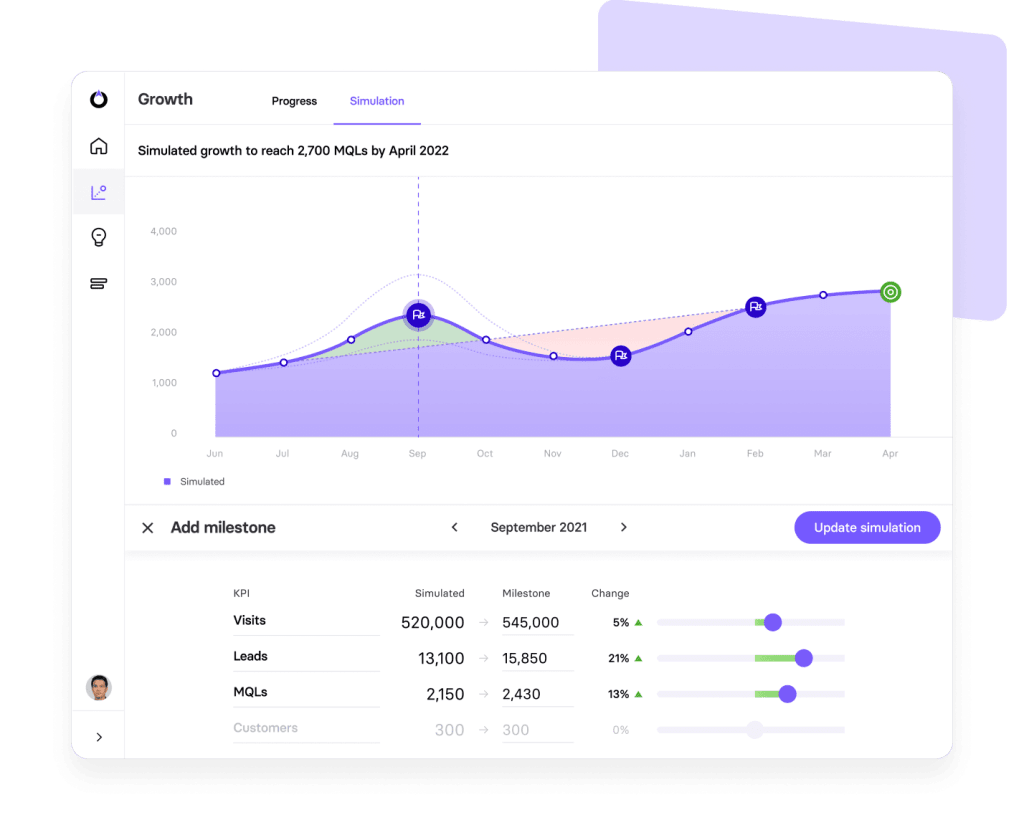
We touched on this earlier when we talked about TrueNorth’s campaign simulator, which allows us to predict the performance of campaign ideas before we invest any resources. Once the results are in, we can adjust our marketing backlog to prioritise the tasks predicted to win the biggest gains and achieve our goal within the time frame of our sprint.
If the numbers don’t add up, we can adjust parameters in the simulator until we reach an acceptable outcome and determine whether we need to rethink the time frame of the sprint to achieve our goal (or, possibly, even rethink the goal itself).
#3: Choose your sprint tasks
With your marketing backlog prioritised, you can now choose the tasks and marketing actions to be completed during your sprint. If you’ve estimated story points or predicted campaign results, you should have a good idea of which tasks are going to achieve your goal within your sprint run.
As you piece your sprint tasks together, you can Start setting daily goals and objectives to meet throughout the sprint run. As a general rule, you should aim to complete a key step in the run every day.
For example:
- Day 1: Planning.
- Day 2: Design all mockups, resources, etc.
- Day 3: Develop all landing pages, emails, etc.
- Day 4: Launch all campaigns.
- Day 5: Test & fix errors.
This is typical of the sprint format but, keep in mind this was developed by software companies during the 1980s, not a team of marketers. When it comes to launching and (especially) optimising marketing campaigns, the data constraints mean you can’t complete every task in a single day.
So, even if you stick to the schedule above for launching your campaigns, you may spend days 6, 7 and 8 tracking performance and optimising campaigns to hit targets – perhaps, even longer.
That said, as a general rule, you should aim to complete non-analytical rounds of work within 1-2 days and try to keep sprint runs within 5-14 days, where possible. In some cases, you may need to run certain sprints for up to 21 days or so but you start losing the agile benefits of sprint marketing if you run into the fourth week.
If you’re really struggling to plan sprint runs of 5-14 days, you might want to consider an adapted version of the Scrum methodology, often called Scrumban (Scrum + Kanban) or Modified Scrum.
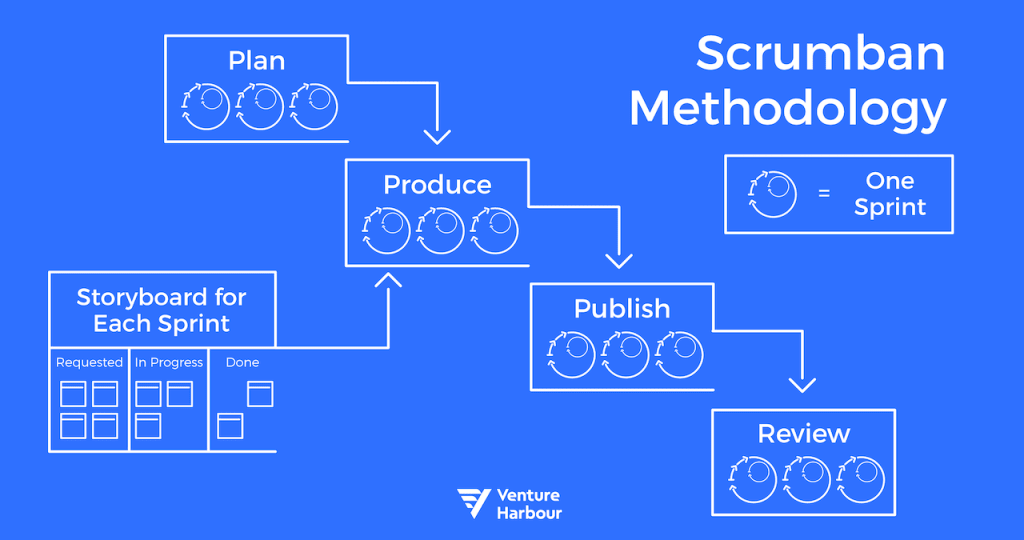
To learn more about the Scrumban methodology and the role it plays in agile marketing, take a look at our guide on how to implement agile marketing.
#4: Assign tasks to the right team members
You may have a good idea of the team you need once you define your sprint goal but this could change by the time you set out your tasks and put your schedule together. Maybe you don’t need some of the people you initially expected to have on the team or, perhaps, you need some people you didn’t think of right away.
Now is the time to specify your team and assign them their tasks, ensuring your sprint team is as focused and lean as possible for achieving your goal.
Before each sprint run kicks off, every team member should have a clear understanding of their roles, a schedule of the tasks they need to complete on a daily basis and key goals/objectives to achieve every day.
#5: Set/review the duration of your sprint
By this point, you should know how long your sprint needs to run to achieve your goals. If you initially set out with a duration in mind, you may have to revise and adapt the schedule if your goal isn’t achievable in your original time frame.
This is quite common during the early days of sprint marketing when it’s more difficult to accurately estimate the time and resources required to complete every task on your backlog. As your Scrum process matures and you gather more data from previous sprints, you’ll be able to make these predictions with greater accuracy.
#6: Put together your strategy/campaign ideas
Generally, the first day of a marketing sprint is dedicated to research, planning and strategy. However, you don’t need to wait until your sprint begins to start putting ideas together. In fact, we send automatic idea requests to team members ahead of sprint runs to get the creativity flowing early and give people the opportunity to think things over by themselves before they’re in a meeting room filled with other people.
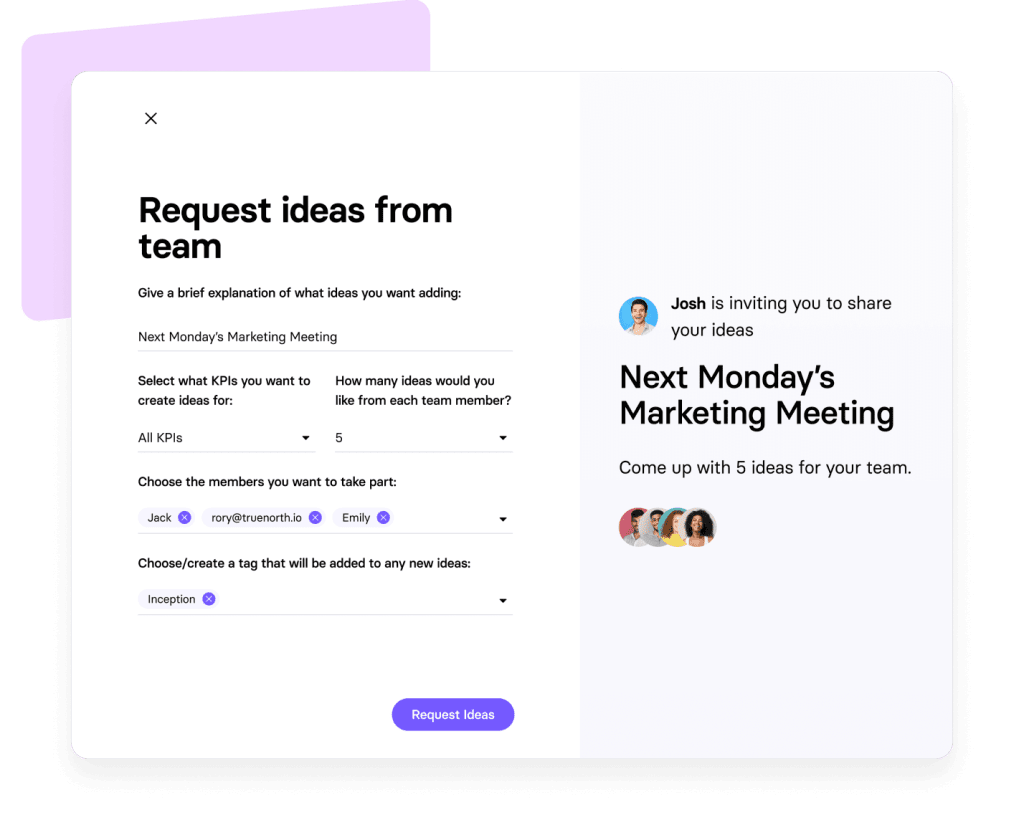
This helps us kick-start the first day of our sprints with a list of ideas to discuss and our team members have already had an opportunity to prepare and collaborate. This means we’ve already made some progress before the sprint begins and we’re ready to get things moving right away. Nobody’s sitting in the meeting trying to think of something to say and we’ve already filtered out some of the not-so-good ideas by automating the stage of the creative process.
When the first day of the sprint begins, we’re ready to start exploring ideas in further detail and discuss the specifics of how we’re going to make things work. We can also collaborate as a complete group and get outside perspectives on ideas and come up with new ones we hadn’t thought of individually.
Before the end of the first day, we’ll have a complete set of campaign ideas for the duration of the sprint.
We’re not going to run with all of them and we should have multiple campaign ideas for some or each objective. This is a preliminary list of campaign ideas and our next task is to prioritise and choose which ones will help us achieve our goal(s) most effectively.
#7: Choose the campaigns to run with
With your preliminary list of campaign ideas complete, you have to choose which campaigns you’re going to run. You need some kind of system for ranking campaign ideas that assess multiple factors: the predicted effectiveness, cost, the time and resources required, the difficulty, etc.
As explained earlier, we use the campaign simulator in TrueNorth to predict the outcome of campaign ideas and score them on the following:
- Priority
- Impact
- Confidence
- Ease
So we’ve estimated our story points to consider time, resources and difficulty and TrueNorth gives us performance predictions and automatically prioritises campaign ideas based on impact, confidence and ease.
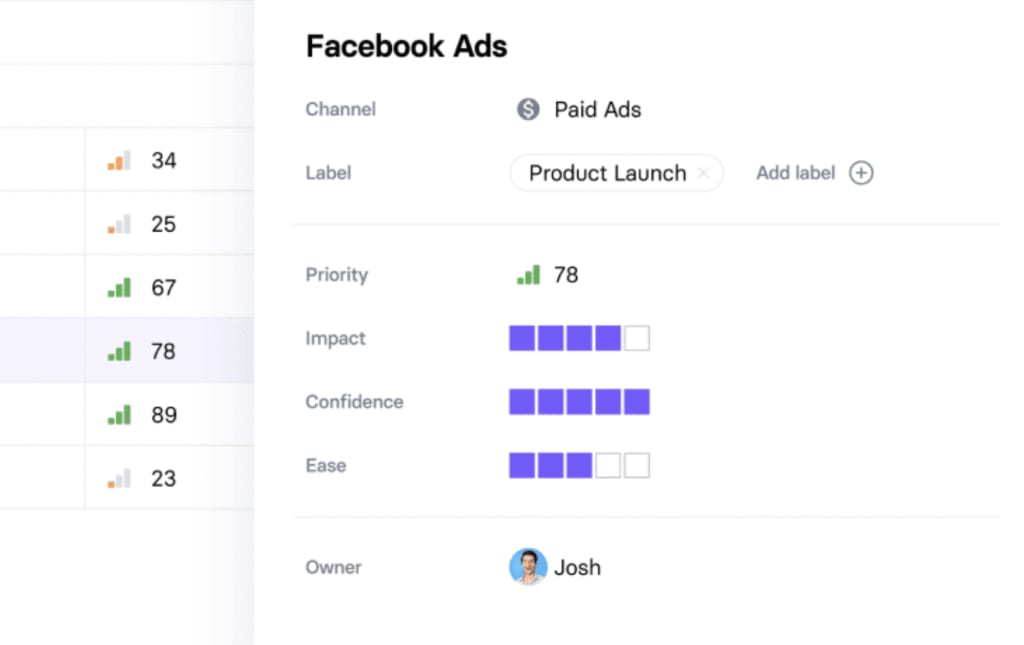
This automated system helps us choose the best campaign ideas to run with, based on data-driven predictions rather than ego and intuition – and it’s completely automated.
#8: Set daily goals & milestones
Every day of a marketing sprint should have a clear goal that takes you a significant step closer to achieving the primary sprint goal. In most cases, this goal marks the completion of a key stage of the sprint (eg: the design stage, development stage, launch stage, etc.) as you can see from the example sprint we looked at earlier:
- Day 1: Planning.
- Day 2: Design all mockups, resources, etc.
- Day 3: Develop all landing pages, emails, etc.
- Day 4: Launch all campaigns.
- Day 5: Test & fix errors.
In addition to daily sprint/team goals, individuals should also have their own daily goals to ensure they have specific targets to hit every day.
When it comes to launching campaigns, you should set performance milestones that need to be hit in order to achieve your primary goal by the end of the sprint.
For example, you might determine that a new landing page should generate 1,000+ visitors on the first day of launch from PPC ads with a conversion rate of 3.5% with traffic numbers increasing to 1,250+ visitors on day two and 1,500+ on day three. By day five, you could set a milestone of 2,000+ visitors and an improved conversion rate of 6% once you’ve had time to optimise your PPC campaigns.
By setting milestones, you can confirm performance is meeting expectations sooner and address issues before they hurt performance beyond repair.
#9: Identify sprint challenges
The final key stage of planning a marketing sprint is to identify the challenges you’ll have to overcome to achieve your sprint goal. Start with the goal itself and make a list of challenges that could prevent you from achieving or make it necessarily difficult.
Then, work backwards and identify challenges for sprint objectives, milestones and individual tasks until you’ve drawn up a list of every legitimate challenge your team can think of – anything that might prevent you from achieving daily targets.
Once you’ve got your list of challenges, determine how you can overcome them, one by one.
Hopefully, you’ll be able to take pre-emptive steps before your sprint begins to remove certain challenges from the equation altogether or severely mitigate the risk of negative impact. Let’s say someone in analytics flags up a campaign idea that will require ongoing optimisation beyond the sprint run, making it difficult to know whether performance will be sustainable once the sprint comes to an end.
There are several ways you could solve or mitigate this issue, such as dedicating resources outside of the sprint for ongoing optimisation, using historical performance data from similar campaigns to model performance forecasts or prioritising other campaign ideas that are expected to produce more sustainable results.
The point is, by flagging these challenges, in the first place, you can take reasonable steps to overcome them before the sprint begins.
Not all challenges require such drastic steps, either. Another issue could be as simple as a software tool being too slow or cumbersome to complete certain tasks quickly enough and swapping to something more suitable could solve the problem outright.
Running your first marketing sprint (example)
To illustrate how all of the points we’ve covered in this article come together, let’s go through an example of a sprint run and break down the day-by-day process. The roadmap for each sprint run varies depending on your goal and the nature of your tasks (eg: marketing campaign, product launch, conversion optimisation, etc.) but the same general principles apply.
In this example, we’re going to explore a hypothetical 8-day sprint for launching a marketing campaign to promote the latest version of an existing product. The update brings new features and a redesigned interface to our imaginary software product, which need promoting to existing customers and new prospects.
So our 8-day sprint schedule looks like this:
- Day #1: Planning, research & strategy
- Day #2: Asset production & prototyping
- Day #3: Implementation & testing
- Day #4: Launch Day!
- Day #5: Analysis
- Day #6: Early adjustments
- Day #7: Optimisation roadmap
As we can see, each day is assigned a specific task and this makes it easy to set specific daily goals with hard deadlines. For certain sprints, you may need more than one day for data-oriented tasks, such as analysis and campaign adjustments but tasks like ongoing optimisation should be performed outside of the sprint.
In the last section, we covered the planning process prior to day #1 of a sprint so, now, we’re ready to jump into the first day of team planning, research and strategy.
Day #1: Planning, research & strategy
Daily goal: Create a set of campaign ideas & approve the best campaigns for launch.
By the end of the first day, we want a final list of approved campaign ideas that we’re going to run with for the duration of our sprint. earlier, we talked about how we use ideation outside of the sprint to draw up a preliminary list of campaign ideas so we’re not heading into the first day with a blank canvas.
Our schedule for day one may look like this:
- AM: Discuss campaign ideas on the list, explore them in more detail and narrow down the best options by identifying challenges and potential weaknesses (include space for discussing new ideas not on the preliminary list).
- 1 PM – 3 PM: Select the top five campaign ideas and lay out the details for each campaign: time frames, resources, assets, personnel, etc.
- 4 PM – 5 PM: Simulate the top five campaign ideas, select the top three performers and finalise the strategies for approval.
By the end of the day, we’ve got three campaigns approved for launch and we’re ready to start preparing assets on day two.
Day #2: Asset production & prototyping
Daily goal: Prototype & produce all of the resources required to launch each campaign.
By the end of day two, we want to have all of the resources and assets required for each campaign designed and ready to develop, implement or launch. This might include landing pages, emails, product images, explainer videos, display ads and a range of other assets.
As we’re running campaigns to promote the latest version of an existing product, we should have a lot of existing assets that we can edit to include the new UI and features. So we may not be creating an explainer video from scratch but inserting footage and screenshots of the updated version into an existing video. Likewise, we would already have landing page and email templates to work with, as well as style templates, colour schemes and other conventions for visual content.
Once we’ve got all of our assets, prototypes and mockups ready, we can sign off the workload for day two and get ready to put everything in working order.
Day #3: Implementation & testing
Daily goal: Set up each campaign ready for launch & test run everything to check for potential issues.
By the end of day three, we want everything in our campaigns set up and ready for launch the next day. This means key assets like landing pages and emails must be developed and tested while delivery systems such as our email automation workflows and remarketing campaigns should be set up and tested so everything is in working order for launch day.
Our schedule for day three may look something like this:
Morning
- Develop landing pages
- Develop emails
- Create email lists
- Create organic content
- Build email automation workflows
- Set up Google Ads campaigns
- Set up remarketing campaigns
1 PM – 3 PM
- Check landing pages and emails render properly
- Check for broken links
- Check visual content
- Test loading times on landing pages, emails and pages they link to
- Test interactive elements – eg: CTA buttons
- Check for JavaScrip errors
- Test the response times of interactive elements
- Test run automation workflows
- Check Google Ads campaign settings
4 PM – 5 PM
- Run a final round of checks to ensure everything is ready to launch tomorrow
Day #4: Launch Day!
Daily goal: Launch each campaign, run preliminary checks and fix any issues that arise on the first day.
Today’s goal is to hit the launch button on all three campaigns and make sure everything is up and running smoothly. Yesterday’s testing should have ironed out any issues that could cause launch problems so we can launch our campaigns first thing in the morning and spend the rest of the day monitoring performance to check that everything is working as it should.
We probably want to launch our campaigns well before the business day begins or schedule things the previous day (whether possible) so that everything is up and running when our target audience is most active.
The majority of day four is spent checking for any teething problems and making sure the launch goes to plan. For example, we may find our PPC campaigns are generating less traffic than we expected, in which case we would need to take a look at reporting to see whether we’re getting impressions and no clicks or something is preventing our ads from showing altogether.
Stick to checking for technical issues and don’t get distracted by performance, unless there’s something obvious wrong that only requires a simple fix. For example, if your campaigns are generating traffic but users aren’t converting on your landing pages, don’t start fiddling with campaign settings and A/B testing your CTAs.
As long as everything is in working order, let the campaigns run and give your analytics team a bit of time to track performance.
Day #5: Analysis
Daily goal: Check performance is in line with projections & flag up anything that needs attention.
By the end of day five, your analytics team will identify which campaigns and assets are in line with projections and any potential issues that need further attention. I say “potential issues” because it’s too early to say that you’ve got a dud landing page simply because it’s not hitting your conversion target on the first day.
Not only that, but underperforming conversion rates aren’t necessarily a landing page problem, to begin with. It could have more to do with the quality of traffic your ad campaigns are generating or a lack of purchase intent from people clicking through from your organic content (if you’re even getting any organic traffic at this point).
Day five isn’t the day for pulling things apart and making drastic changes; it’s the day for your analysts to track performance and monitor results vs projections for the first 24-hour (or so) period.
Day #6: Early adjustments
Daily goal: Adapt campaign settings for anything that’s off-target & get performance back on track.
Day six is the first day where you might start to make early adjustments on campaigns or assets showing early problems signs. Let’s say landing page visitors aren’t scrolling far enough down the page to reach our primary CTA or we’re not winning enough auctions in Google Ads to generate the traffic we need.
In response to issues like these, we may set up a quick A/B test where we move the primary CTA further up the page or rethink our page copy to increase incentive. Alternatively, we might want to narrow our targeting options in Google Ads to increase the relevance of our traffic.
However, if we’re already not winning enough auctions to hit our traffic targets, we need to address this problem first. This could mean upping our bids or optimising them to spend more at peak times or, even, testing automated bidding strategies to see if they outperform our own methods. If we don’t have the budget for increased bids, we may focus on the quality of our campaign and ads by checking our Quality Scores to see if there’s room for improvement, as this can lower the amount we need to bid to win auctions.
We could also test ad variations to make our ads more compelling and find a message that primes more visitors to take action after they click through.
Day #7: Optimisation roadmap
Daily goal: Lay out the optimisation roadmap for each campaign, based on early results.
By day seven, our campaigns are running and we’ve got a couple of days’ worth of data to help us gauge early performance. However, it’s still too early to know what the long-term performance of these campaigns will look like and we’re not ready to make any drastic changes yet.
Instead, we’re going to lay out an ongoing optimisation roadmap that extends beyond the marketing sprint.
Obviously, every campaign requires continued performance tracking and optimisation and we have our processes for managing this: personnel, automation tools, A/B testing campaigns and weekly check-ins. However, each campaign is unique and the early analysis and adjustments made during our sprint run help us determine the best optimisation roadmap for each campaign.
As mentioned in the previous two sections for days five and six, we can’t draw any definitive conclusions from 48 hours of analysis but we can flag up any obvious issues that need immediate attention. We can also identify creatives and assets that aren’t yet in line with our projections for the first few days and flag these up for monitoring or intervention if there’s a clear issue.
This helps us prioritise tasks in our optimisation roadmap in the same way we prioritise tasks in our backlog so we’re ready to dedicate resources to where they’ll have the biggest impact in the shortest time frame.
Sprint review
At the end of every sprint run, you should hold a sprint review meeting to analyse the processes and the results of the sprint. Generally, these only need to last an hour and you may want to hold a sprint review at the end of every week for runs lasting 10 or more days.
Sprint reviews are very similar to another type of meeting, commonly called marketing retrospectives. Technically, marketing retrospectives are held at the end of campaigns but the general structure of these two meetings is the same although retrospectives may run for more than one hour.
The reason I mention this is because we’ve got an in-depth guide on how to run marketing retrospectives and all of the information in that article applies to sprint reviews for marketing teams.
Essentially, the goal is to determine three key things at the end of every sprint:
- What went well?
- What went poorly?
- What can we improve?
By discussing these talking points, the aim is to improve your marketing processes so that you can achieve your sprint goals more effectively in the future. At the end of your sprint, you should have enough data to know what did and didn’t work but a sprint review can help you determine why certain things succeeded and others didn’t.
With these insights, you can apply three takeaways to future sprint runs:
- What to keep doing for similar campaigns, strategies and marketing actions.
- What to stop doing or optimise to improve results in similar scenarios.
- What to do differently in your marketing processes for future sprints.
Sprint reviews also give everyone on your team the opportunity to raise any issues that aren’t reflected in your data. This could be as simple as certain tools being cumbersome to use at certain points of the sprint or bigger issues with broader marketing processes that need addressing before the next sprint.
Get more done, faster with effective marketing sprints
Marketing sprints provide a concise framework for agile teams to hit targets big and small in a shorter time frame. With a constant focus on progress and rapid turnaround times, you can build a culture of getting fast results and adapting to constant change – a common challenge for modern businesses in the digital age.
Running successful sprint runs requires careful planning and constant analysis of marketing processes to improve results. Hopefully, everything we’ve covered in this guide will help you plan marketing sprints that hit daily targets, achieve project goals and empower your team to make bigger things happen.




